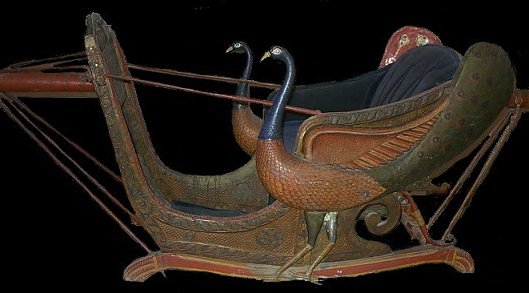 |
|
Indian Road TripsIn India you become very much aware that a vehicle is nothing but a motor which drives wheels under a container. People cram into buses and rickshaws anyhow, many hanging out of the back. The combination of bumpy roads, hard seats and lack of suspension can make driving an uncomfortable experience for some. It is also rather slow as most roads are approximately one lane in each direction. Sometimes the actual tarmac is only wide enough for one vehicle, so when you meet oncoming traffic your car moves with one tyre on the tarmac and one usually much lower in the dirt at the side whilst the other car does the same. The roads are built by hand and the surfacing is generally much thinner than we use, in combination with the weather conditions this leads to ample potholes. I enjoyed driving despite the 'saddle-soreness' - it was my opportunity to observe rural and urban India without receiving the unwanted attention usually paid to foreigners. Many people have said they find Indian driving scary, but I never found it so, though we drove everything from Mumbai and Delhi to rural backroads. Even the rickshaw drivers in Delhi failed to raise the hair on the back of my neck. It is simply a different system that you have to get used to. All of our drivers were perfectly competent at handling Indian traffic but it may be a good thing that tourists do not usually drive their own cars. In any case most of the drivers on the Indian roadways are professionals - Indians rich enough to drive around in cars are often also rich enough to have chauffeurs. It is easy to see that our style of traffic system would never do for India, since it is based on the principle that there are really only one or two types of road user, and that they are mostly the same width and can travel at the similar speeds. On the Indian roads we saw: cars, trucks, local buses, tourist coaches, scooters, rickshaws, bicycles, bullock carts (full & empty), camel carts, donkey carts, herds of cattle, camels with riders, two elephants with riders, people, pigs, etc. Each of these moves at its own speed and sometimes they stop for one reason or another. A coach we were in once stopped in the middle of the road because several passengers wanted to photograph opium poppies! Generally, the traffic in India moves so slowly, you are lucky to do 50 kms/h and so there are more minor knocks than serious accidents. Technically, you drive on the left, but this is more of a generalisation than a frequently obeyed rule. In reality, you weave your way through the obstacle course of stopped, slow or oncoming vehicles as best you can, bearing left when possible. It is customary and expected for motor vehicles to blow their horns when they pass anything else, perhaps because relatively few of the things mentioned above have rearview mirrors? This makes road traffic cacophonus as well as uncomfortable but I decided to get into the spirit of the thing and enjoy it. All along the Indian roads are cafes which play the same role as highway rest stops for us. They come in varying degrees of salubrity and charm, though the two do not always go together. Indian sterility is marked by the use of plain concrete, rather than the plastic we use. I vaguely remember France in the '70s looking quite similar, but I found myself prefering cafes made of bits of ancient wood stuck together any old how and painted. The drivers know how to tell the 'good' cafes from the 'bad' ones, but it is rather a difficult art for tourists who are used to other criteria of judgement. We had one driver for nine days and we liked him very much, we got to know him better than many of our guides. We were quite curious to know how he spent his nights after driving us around all day. On some occasions a driver might sleep in the car, but we discovered that in many cases the hotels provide special accomodation for drivers at a lowish rate. This seems to be usually a kind of dormitory arrangement, in one case our driver found his accomodation to be pretty luxurious, on another he complained that there was no water, though I couldn't say if that was a permanent feature of the place or a temporary problem. Drivers get together in the hotels every night, and they seem to enjoy the social life. Though they are often away from their families for long periods, they get to meet other drivers from all over, and must be among the best travelled Indians. Ours had driven from his home in Karnataka all the way to Delhi on one occasion. Apart from socialising, it was our drivers task to fill up the car and get any minor problems fixed while we weren't there, with the result that we never saw a garage or a petrol pump. |